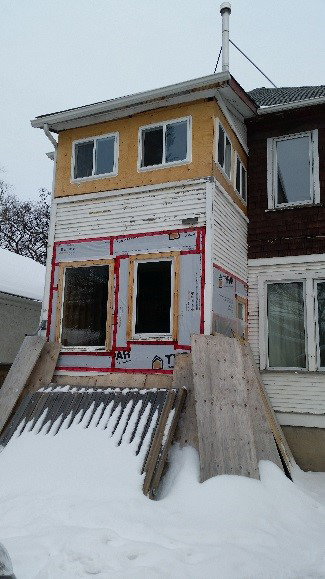The writer is a member of the Canadian Home Builders’ Association (CHBA).

This project involved a rental property that needed renovations to an addition. The planned changes were not complex, and for most professional renovators would have been a relatively small project. There was a 2-storey addition in place. The original goal for the project was to install a new foundation and a new first floor while retaining the second-floor room.
The property owners found a contractor who appeared presentable and said he could do the work required. The contractor proceeded to get engineered plans for the work, quoted a total price of $30,000, obtained a building permit and signed a contract with the owners including a $20,000 deposit.
What Went Wrong?
In order to make the existing basement usable the floor had to be lowered. This work appeared to be done by hand shovelling and the new concrete floor varied in depth from 1/2” to 6”. There were no footings installed to support the basement wall and the framing that done was inadequate. When the municipal inspector came to the property to check on the work, he issued a deficiency report, citing these problems.
At this point, it became clear to the owners that the hired contractor was not a professional. He failed to follow the obtained engineering drawings of the work that was needed as he had little experience and no financial ability to deliver the project he had taken on. By the time the owners decided that they had enough, the project had dragged out for a year. The $20,000 deposit was gone, the contractor was gone, and the signed contract was too vague to enforce. It was impossible to meet the original $30,000 estimate with the work required.
An Avoidable Disaster
Our company was contacted and we prepared a price for the work. Our review and engineering showed that the completed 2-storey addition needed to be removed and the excavation re-dug. New engineering plans were drawn, a proper scope of work was prepared, and the work was costed to be closer to $60,000. In order to save money for the owners, the original concept was changed to create a usable deck for the 2nd-floor tenant instead of a room.
The project was completed in 4 months on time and on budget. The municipality performed all the required inspections to confirm things were now done properly. Had the owners gone with an experienced builder/renovator, a detailed scope of work, plans, and a payment schedule, the loss of $20,000 on this project could have been avoided.
These types of renovation disasters are avoidable. Property owners need to do their part by properly checking out prospective contractor ahead of time.
For reliable information on how to find, interview, evaluate, check references and get a contract with the “right” renovator, you can get informed at the Canadian Home Builders’ Association website: www.GetItInWriting.ca
